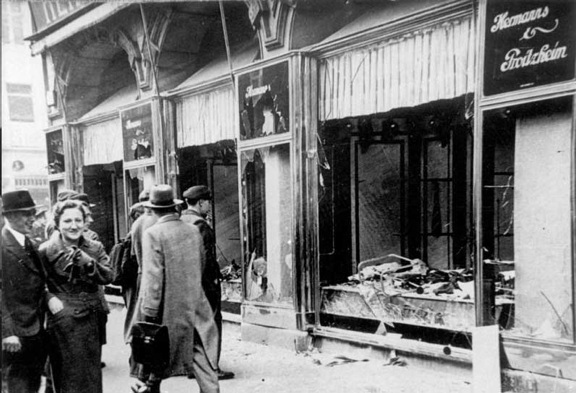Kristalnacht- The Night of the Broken Glass
In late October 1938 , Hitler ordered the expulsion of all Polish-born Jews from Germany to Poland. There were about 20,000 Jews who soon found themselves stranded along the border. On November 8th, Herschel Grynszpan, (the son of one of the Polish Jew, who was living in Paris), shot Ernst Von Rath (the third Secretary of the German Embassy). Von Rath later died. Hitler used this assault as an excuse to attack the Jews of Germany and Austria. He gave the SS, and other Nazi groups the green light to attack Jewish targets throughout Germany. They burned down 76 synagogues, attacked Jews in the streets, and broke the glass of every Jewish business they could find. The reaction around the world was one of revulsion. There was suddenly a realization in America of the true nature of the Nazi regime.
As part of the ongoing campaign against Jews, the Nazis government announced in August that those Jews who had foreign residence permits would have their permits revoked. On October 28, 1938 on the orders of Hitler, all of Polish Jews who lived in Germany were forced from their homes. They were allowed to take only one suitcase. They were put on trains that brought them to the Polish border. Over 12,000 were taken to the border. 4,000 were allowed into Poland, and the remaining 8,000 were left in the no man's land between Germany and Poland.
Among the families that were sent to the border were Sendel and Riva Grynszpan who had emigrated to Germany in 1911. Their son was living with his uncle in Paris, and he received a postcard from his parents asking for help. He went and shot a consul at the French embassy in Paris, Ernst vom Rath on November 7th. Vom Rath died of his wounds on November 9th. The Nazis leadership were at a party celebrating the anniversary of Munich Beer Hall Putsch. Hitler left the party, and Propaganda Minister Joseph Goebbels gave a speech and said “the Führer has decided that... demonstrations should not be prepared or organized by the party, but insofar as they erupt spontaneously, they are not to be hampered.”. That was seen as a green light to attack Jews in Germany.
The police were ordered to see Jewish males, and the police were instructed not to interfere with attacks on the Jewish property. In the course of the night, the storefronts of 7,500 Jewish stores and business were shattered. Almost all of the synagogues on the country were damaged some burned to the ground. 30,000 Jews were arrested and sent to concentration camps. The Jewish community was fined 10 Billion Reichsmarks.
Kristallnacht was a turning point both inside Germany and outside. In Germany, until then the persecution of the Jews was through laws, discrimination and economic actions but mostly not through physical means. From Kristallnacht forward acts against German Jews became physical. Outside of Germany, it became clear that the Nazis acts against Jews were no longer a familiar form of antisemitism. However, something different and far more dangerous. While no one foresaw the final solution opposition to the Nazis outside Germany grew dramatically.
 >
>